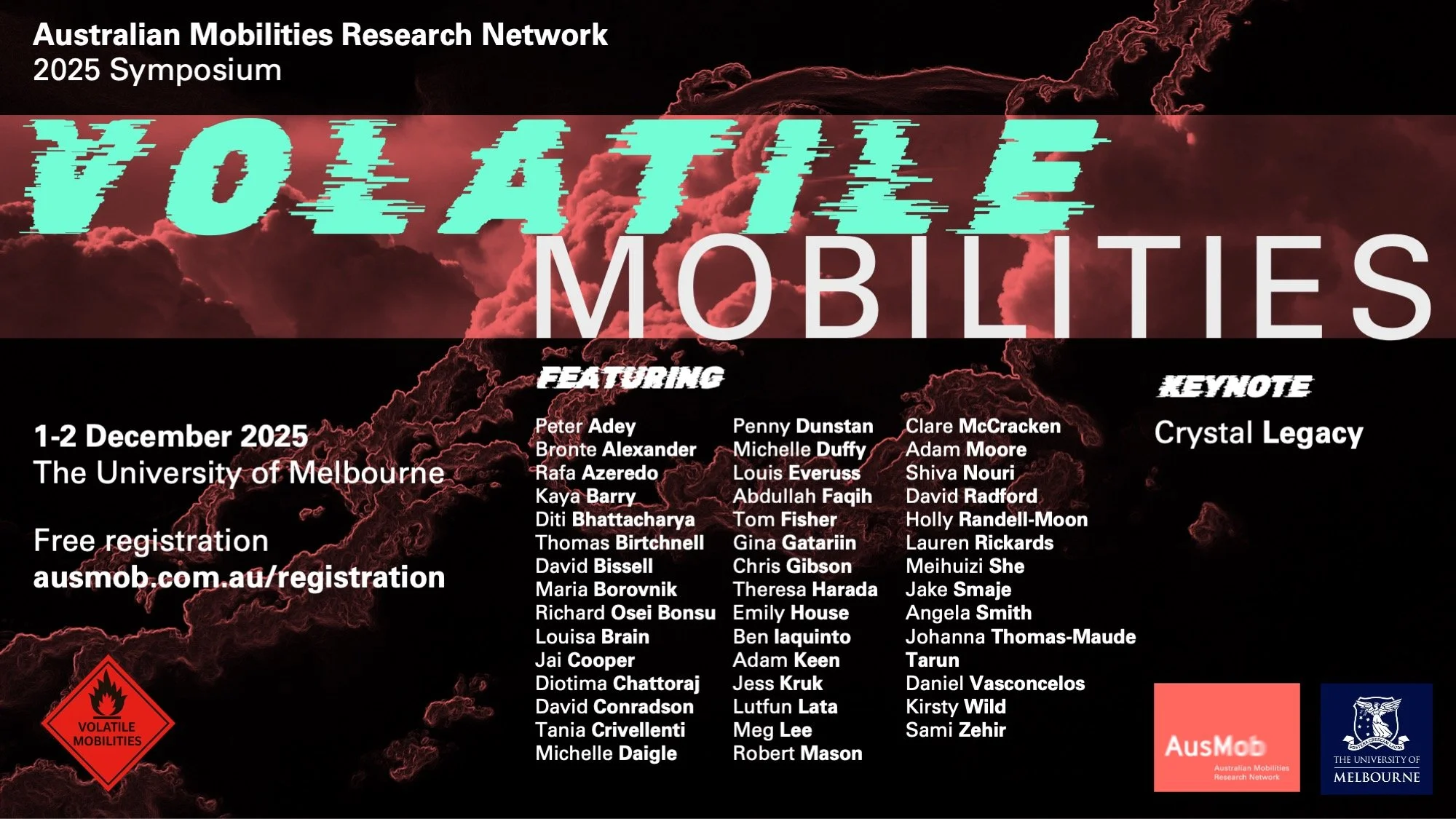AusMob 2025 Symposium: VOLATILE MOBILITIES
1-2 December 2025, Melbourne
Though it’s not a concept that mobilities researchers have engaged with head-on, volatility feels like a compelling watchword for the mobilities of our time, because it speaks of a world of instability, danger, fear, uncertainty, turbulence and overlapping crises (Temenos 2025). Think about the sheer range of circumstances involving mobility that seem inherently volatile, from the unpredictability of border and visa regimes, to human displacements from war (with real, technical and affective explosiveness), to missiles criss-crossing borders, closing airspaces and penetrating bunkers and bodies. But pushed further, the concept of volatility also seems to be at the heart of everyday life under economic precarity, the strange and elemental forces of climate change-induced disasters, and migrant lives put under threat from persecution and deportation. Volatility seems to name circumstances and events puncturing our times through volatile (im)mobilities, and those volatilities can undo assumptions of order, intention and agency (Bissell 2012). These are also tumultuous grounds for ethics, of “contexts marked by unpredictability and uncertainty, by ongoing processes of transformation and thus (potentially) rapidly changing dynamics [...] by ambiguity and variegated constraints“ (Fleschenberg and Castillo 2020: 500).
Of course volatile qualities are not necessarily negative qualifiers or things to be contained. Volatility has its thrills and pleasures too, especially in the radical expansion and contraction of what a mobile body—and even mobile things—can do. Many things, even the invisible, immaterial and ephemeral, are literally and categorically volatile, such as the scents that escape substances to surprise us with pleasure and sometimes disgust, making up a chemical environment of trails, eddies and dissipations (Kitson and McHugh 2019). Volatility is even lauded by US Presidential supporters as a positive charismatic quality of leadership exuded from a body, where calmness or resolution were once ways to weather the winds of change. Volatility might also feature as myth-making for people at the mercy of the ebb and flow of economies: the promise, or threat, of intensity against repressive norms. Indeed the volatility inherent in the freedom of the road imagined in 1960s counterculture is still endearing for some today.
Volatility implicates relations of mobility and immobility in complicated ways. Picture the scene from the film Falling Down where commuting city worker William Foster (Michael Douglas) abandons his car in Los Angeles gridlock, thereby missing his daughter’s birthday, to go on a violent rampage against capitalist urban America (Cresswell 2002). Here, the relentless (im)mobilities of labour incites volatility within people’s lives. As a brooding undercurrent, volatile immobility is also sometimes hidden. A latent potentiality behind a facade of calm might be indicative of an imbalance between the pressure to move and shortfalls in ‘motility’, or the capacity to become mobile (Kaufmann et al. 2004). Beyond polar opposities—that is, unable to move to freedom or conversely moving hectically to reach a state of calm—there is the troubled state of contemplating volatility. A traveller locked into the sedentariness of an overnight flight before a once-in-a-lifetime journey overseas. Gig workers locked into perpetual mobility to avoid incomes stagnating during periods of non-work. An employee saving up over many decades in a humdrum job to finally ‘escape’ to a more, or less, volatile life upon retirement. There is a significant link between economies and volatile (im)mobilities.
Volatility also appears an apt term for an eruptive material and elemental world, proving excessive to human intervention trying to bring it to heel; for contingent ‘volatile bodies’ escaping social categorisation and normalisation (Grosz 1994); for economic strain pressuring everyday lives under financial shocks and crisis; and violent geopolitical movements fracturing orders, alliances, and trading relationships. For the lucky some, COVID lockdowns may have meant a kind of unimagined immobility which brought temporary respite; while for others, volatility captures the compounding risks of networked worlds.
Edited collection
An edited book collection on the theme of ‘Volatile Mobilities’ is a potential output of this symposium subject to interest.
References
Bissell, D. (2012). Agitating the powers of habit: Towards a volatile politics of thought. Theory & Event, 15(1).
Cresswell, T. (2002). ‘Falling down: resistance as diagnostic’. In Paddison, R., Philo, C., Routledge, P., & Sharp, J. (eds) Entanglements of power: Geographies of Domination/Resitance, London: Routledge, pp. 256-268..
Fleschenberg, A., & Castillo, R. C. A. (2022). Negotiating Research Ethics in Volatile Contexts. International Quarterly for Asian Studies, 53(4), 495-503.
Grosz, E. (1994). Volatile Bodies: Toward a Corporeal Feminism. Bloomington, IN: Indiana University Press.
Kaufmann, V., Bergman, M.M. and Joye, D. (2004). Motility: mobility as capital. International Journal of Urban and Regional Research, 28(4): 745-756. https://doi.org/10.1111/j.0309-1317.2004.00549.x
Kitson, J., & McHugh, K. (2019). Olfactory attunements and technologies: Exposing the affective economy of scent. GeoHumanities, 5(2), 533-553.
Temenos, C. (2025). Mobilities I: Crisis. Progress in Human Geography, https://journals.sagepub.com/doi/pdf/10.1177/03091325251352538



